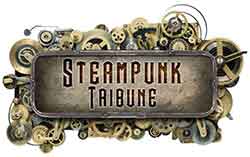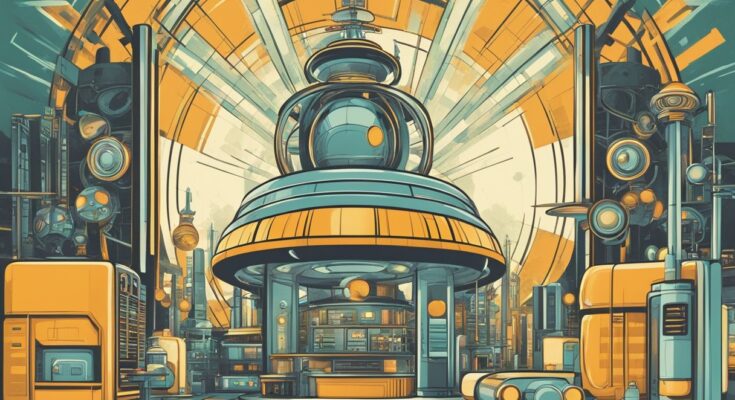Atompunk is a subgenre of science fiction that takes place in an alternate timeline where the atomic age never ended. It is a retro-futuristic style that draws inspiration from the aesthetics and technology of the 1940s and 1950s, but with a sci-fi twist. Atompunk is characterized by its use of atomic energy, futuristic technology, and a sense of optimism about the future.
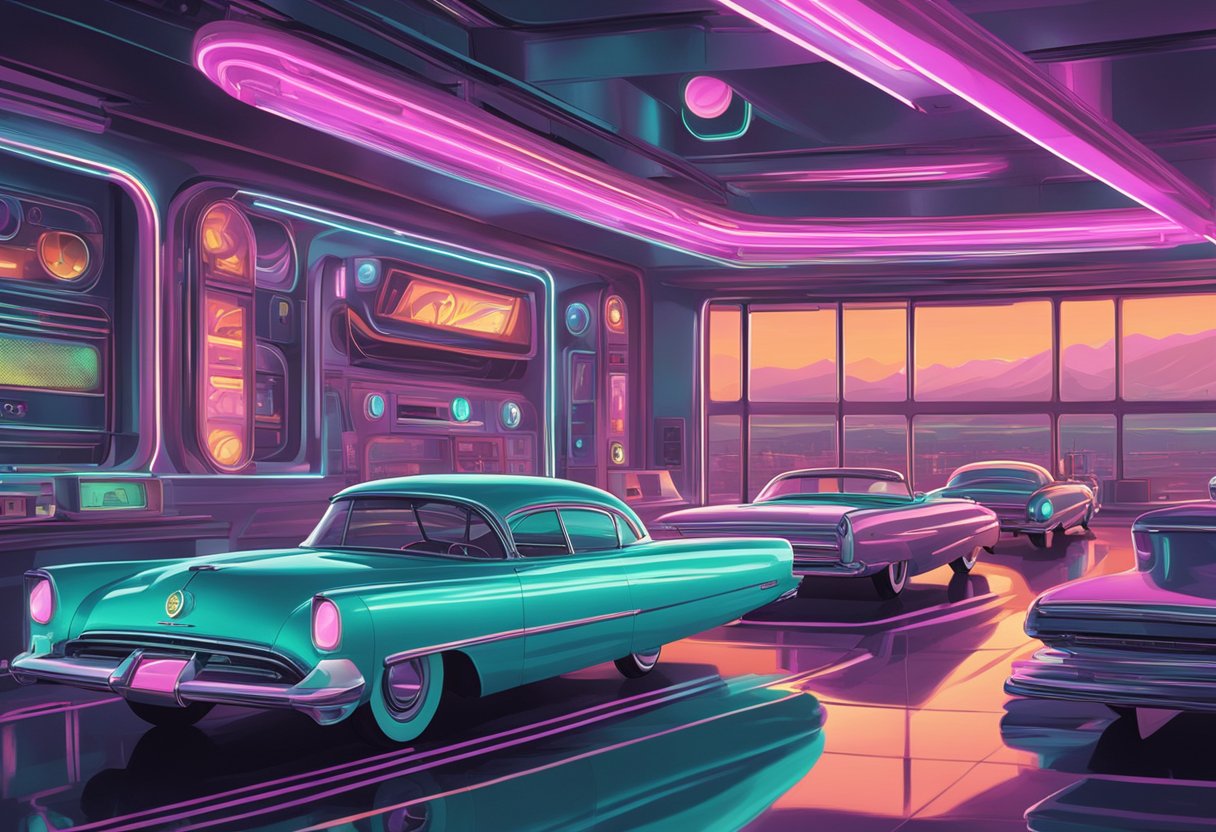
The term “atompunk” is derived from “steampunk,” another subgenre of science fiction that takes place in a world where steam power is still prevalent. Atompunk is often associated with the punk subculture, which emphasizes individuality, anti-authoritarianism, and DIY ethics. However, atompunk is not necessarily political in nature and can be enjoyed by people of all backgrounds and beliefs.
Atompunk Aesthetic
Atompunk is a retro-futuristic aesthetic that draws inspiration from mid-century modernism, art deco, and streamline modern. It is characterized by its use of geometric shapes, vibrant colors, and futuristic technology, all of which reflect the optimism and excitement of the Atomic Age.
Design and Architecture
Atompunk design and architecture are heavily influenced by the Googie architecture movement, which emerged in the 1940s and 1950s. Googie architecture is known for its use of bold, futuristic shapes, such as boomerangs, flying saucers, and atomic symbols. Atompunk buildings often feature these same shapes, as well as sleek lines and a streamlined appearance.
Atompunk design also incorporates elements of art deco and streamline modern, which were popular in the 1920s and 1930s. These styles are characterized by their use of geometric shapes, such as zigzags and chevrons, as well as their emphasis on speed and motion.
Fashion
Atompunk fashion is inspired by the clothing styles of the 1940s and 1950s, but with a futuristic twist. Women’s clothing often features full skirts, fitted bodices, and bold prints, while men’s clothing includes tailored suits and fedoras. Both men and women may wear accessories such as gloves, sunglasses, and scarves.
Vibrant colors are also a hallmark of Atompunk fashion, with bright shades of red, blue, and green being particularly popular. Metallic fabrics, such as silver and gold, are also commonly used, reflecting the futuristic and technological themes of the aesthetic.
Overall, the Atompunk aesthetic is a unique and exciting blend of retro and futuristic styles, characterized by its use of bold shapes, vibrant colors, and innovative technology.
Origins and Influences
Historical Context
Atompunk is a subgenre of science fiction that emerged in the 1950s and 1960s, during the Cold War and the Space Race. It is heavily influenced by the Atomic Age and the Space Age, as well as the suburban lifestyle and the nuclear family that were popular during that time. Atompunk is characterized by its retro-futuristic aesthetic, which combines the design and technology of the 1950s and 1960s with futuristic elements.
Influential Media
Atompunk has been influenced by a variety of media, including literature, film, television, and other forms of popular culture. Some of the most influential works in the genre include William Gibson’s “Neuromancer,” Philip K. Dick’s “Do Androids Dream of Electric Sheep?,” and Isaac Asimov’s “Foundation” series.
In terms of film and television, Atompunk draws inspiration from a range of sources, including “The Jetsons,” “Star Trek,” and “Flash Gordon.” The genre is also heavily influenced by the Raygun Gothic aesthetic, which is characterized by its sleek, streamlined designs and futuristic elements.
One of the most iconic examples of Atompunk in popular culture is the video game “Destroy All Humans,” which features a retro-futuristic aesthetic and a storyline that revolves around an alien invasion during the 1950s. Another notable example is the comic book series “Ignition City,” which is set in a retro-futuristic world where space travel is a common occurrence.
Finally, Atompunk is also heavily influenced by the historical context in which it emerged. The Red Scare, the Atomic Age, and the Space Race all played a significant role in shaping the genre’s aesthetic and themes, as did World War II and the suburban lifestyle that emerged in its aftermath.
Overall, Atompunk is a unique subgenre of science fiction that draws on a range of historical and cultural influences to create a retro-futuristic world that is both familiar and fantastical.
Atompunk in Popular Culture
Atompunk has been a popular subgenre of science fiction for many years, and has been featured in various forms of popular culture. Here are some examples of how atompunk has been portrayed in movies, television shows, books, and video games.
Movies and Television Shows
Atompunk has been a popular theme in movies and television shows, often featuring futuristic and highly advanced technology. Some examples of atompunk in popular movies and television shows include:
- The Incredibles: This animated movie features a retro-futuristic world with ray guns and advanced technology.
- Futurama: This animated television show is set in the 31st century and features many atompunk elements, including robots and advanced technology.
- The Outer Worlds: This video game is set in an alternate future where corporations control everything and advanced technology is the norm.
Books and Literature
Atompunk has also been a popular theme in literature, with many authors exploring the possibilities of a world with advanced technology. Some examples of atompunk in popular books and literature include:
- Do Androids Dream of Electric Sheep?: This book, which was the basis for the movie Blade Runner, explores the idea of what it means to be human in a world with advanced technology.
- The Fallout series: This series of video games is set in a post-apocalyptic world where advanced technology is still present, but often malfunctioning or dangerous.
- Prey: This video game is set on a space station where advanced technology has gone awry, and the player must use their wits to survive.
Video Games
Atompunk has been a popular theme in video games, with many games featuring futuristic technology and advanced weaponry. Some examples of atompunk in popular video games include:
- The Fallout series: This series of video games is set in a post-apocalyptic world where advanced technology is still present, but often malfunctioning or dangerous.
- Fallout Shelter: This mobile game is a spin-off of the Fallout series and allows players to manage their own vault in a post-apocalyptic world.
- Prey: This video game is set on a space station where advanced technology has gone awry, and the player must use their wits to survive.
Overall, atompunk has been a popular subgenre of science fiction for many years, and has been featured in various forms of popular culture. With its focus on futuristic and highly advanced technology, atompunk continues to capture the imagination of audiences around the world.
Atompunk Vs Other Punk Genres
Atompunk is a subgenre of science fiction that emerged in the 2010s. It is characterized by a retro-futuristic aesthetic that draws inspiration from the Atomic Age of the mid-20th century. Atompunk shares many similarities with other punk genres, but also has some key differences.
Atompunk Vs Cyberpunk
Atompunk and Cyberpunk share some similarities, such as a focus on technology and dystopian themes. However, Atompunk is more optimistic than Cyberpunk, and tends to focus more on the past than the future. Atompunk also has a more retro aesthetic, with a focus on the Atomic Age and the Space Race.
Atompunk Vs Steampunk
Atompunk and Steampunk both draw inspiration from the past, but they focus on different eras. Steampunk is set in the Victorian era, while Atompunk is set in the Atomic Age. Atompunk also tends to have a more futuristic and technological feel than Steampunk.
Atompunk Vs Dieselpunk
Atompunk and Dieselpunk both draw inspiration from the early 20th century, but they have different focuses. Dieselpunk is set in the interwar period, while Atompunk is set in the post-World War II era. Atompunk also tends to have a more futuristic and technological feel than Dieselpunk.
Atompunk Vs Decopunk
Atompunk and Decopunk both draw inspiration from the Art Deco movement of the 1920s and 1930s. However, Atompunk is set in the Atomic Age, while Decopunk is set in an alternate history where the Art Deco style continued to dominate. Atompunk also tends to have a more futuristic and technological feel than Decopunk.
In conclusion, while Atompunk shares many similarities with other punk genres, it also has some key differences. Atompunk’s focus on the Atomic Age and its optimistic outlook set it apart from other punk genres.
Characteristics of Atompunk Society
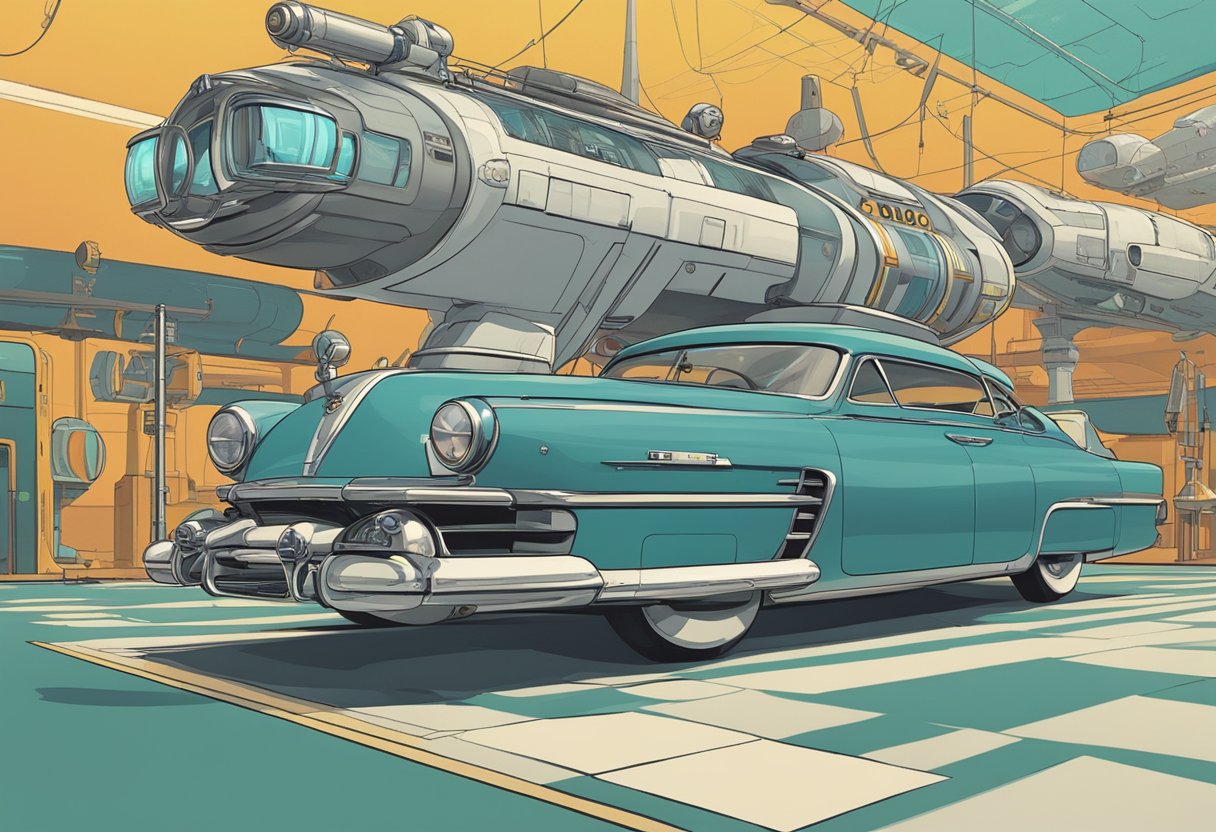
Atompunk is a subgenre of science fiction that is defined by its use of atomic energy and technology. The society in an Atompunk world is often dystopian or post-apocalyptic, with the use of nuclear power leading to devastating consequences.
One of the defining characteristics of an Atompunk society is the prevalence of nuclear technology. This technology is often used for destructive purposes, such as in nuclear war or as a result of radiation exposure. However, it can also be used for positive advancements, such as in the creation of atomic energy.
Communism is also a common theme in Atompunk societies. This is because the use of nuclear power often leads to a centralized government controlling the energy source and its distribution. This can result in a society that is heavily regulated and controlled by the government.
Technological progress is another key feature of Atompunk societies. The use of nuclear technology often leads to advancements in infrastructure and other areas of society. However, this progress is often at the expense of individual freedoms and can result in a society that is heavily monitored and controlled.
Overall, Atompunk societies are defined by their use of nuclear technology and the consequences that come with it. They often portray a world that is both advanced and dystopian, with a centralized government controlling the use and distribution of atomic energy.
Atompunk in Music
Atompunk is a subgenre of science fiction that draws inspiration from the Atomic Age of the mid-20th century. This era was marked by the development of nuclear technology, which had a profound impact on popular culture, including music.
Atompunk music often features elements of swing, jazz, and big band music, which were popular in the 1940s and 1950s. These musical styles are often combined with electronic and experimental sounds to create a unique and futuristic sound.
One notable example of atompunk music is the soundtrack for the video game “Fallout 3.” The game is set in a post-apocalyptic world that draws heavily from the aesthetics of the Atomic Age. The game’s soundtrack features a mix of classic songs from the era, as well as original compositions that incorporate electronic and experimental sounds.
Another example of atompunk music is the band “The Atomic Fireballs.” The band’s sound combines elements of swing and big band music with a modern twist. Their song “Man with the Hex” was featured in the movie “The Mask” and became a hit in the late 1990s.
Overall, atompunk music is a unique and exciting subgenre that draws on the aesthetics and sounds of the Atomic Age. It combines classic musical styles with futuristic sounds to create a sound that is both nostalgic and forward-thinking.
Atompunk in Apps and Technology
Atompunk is a subgenre of science fiction that draws inspiration from the aesthetics and culture of the Atomic Age, which spanned from the 1940s to the 1960s. It is a retrofuturistic style that imagines a world where the technology of the time has advanced in unexpected ways, resulting in a unique blend of futuristic and vintage designs.
In recent years, atompunk has become a popular theme in apps and technology, with designers and developers embracing the style to create unique and engaging user experiences. From retro-inspired interfaces to futuristic gadgets, atompunk has found its way into various aspects of modern technology.
One area where atompunk has made a significant impact is in the development of robots. Atompunk-inspired robots often feature sleek, streamlined designs that blend futuristic technology with vintage aesthetics. These robots are often depicted as helpful assistants, performing tasks such as cleaning, cooking, and even providing companionship.
Another area where atompunk has found a home is in the design of future technologies. Atompunk-inspired gadgets often feature retrofuturistic designs that combine vintage aesthetics with cutting-edge technology. These devices are often designed to be both functional and aesthetically pleasing, with a focus on creating a unique user experience.
Overall, atompunk has become a popular theme in apps and technology, with designers and developers embracing the style to create unique and engaging user experiences. Whether it’s in the design of robots or the development of future technologies, atompunk is a style that continues to inspire and captivate audiences.
Atompunk in Art and Fantasy
Atompunk is a subgenre of science fiction that is heavily influenced by the aesthetics of the mid-20th century, particularly the post-World War II era. It is characterized by a retro-futuristic vision of the future, where technology has advanced rapidly but society remains rooted in the past. This subgenre has found its way into various forms of art, including visual art, literature, and film.
One of the most prominent artistic influences on atompunk is the Art Deco movement. Art Deco was a popular art style in the 1920s and 1930s, characterized by its use of geometric shapes, bold colors, and streamlined designs. Atompunk often incorporates these elements into its visual aesthetic, creating a unique blend of retro and futuristic styles.
Atompunk is also a popular subgenre in fantasy literature and role-playing games. In these works, atompunk often takes on a more fantastical tone, with advanced technology coexisting alongside magic and supernatural elements. This blending of genres allows for a wide range of storytelling possibilities, from epic adventures to gritty noir-style mysteries.
Overall, atompunk is a fascinating subgenre that offers a unique vision of the future. Its blend of retro and futuristic styles, along with its incorporation of elements from other genres, makes it a versatile and engaging genre for artists and writers alike.
Atompunk in Stores and Products
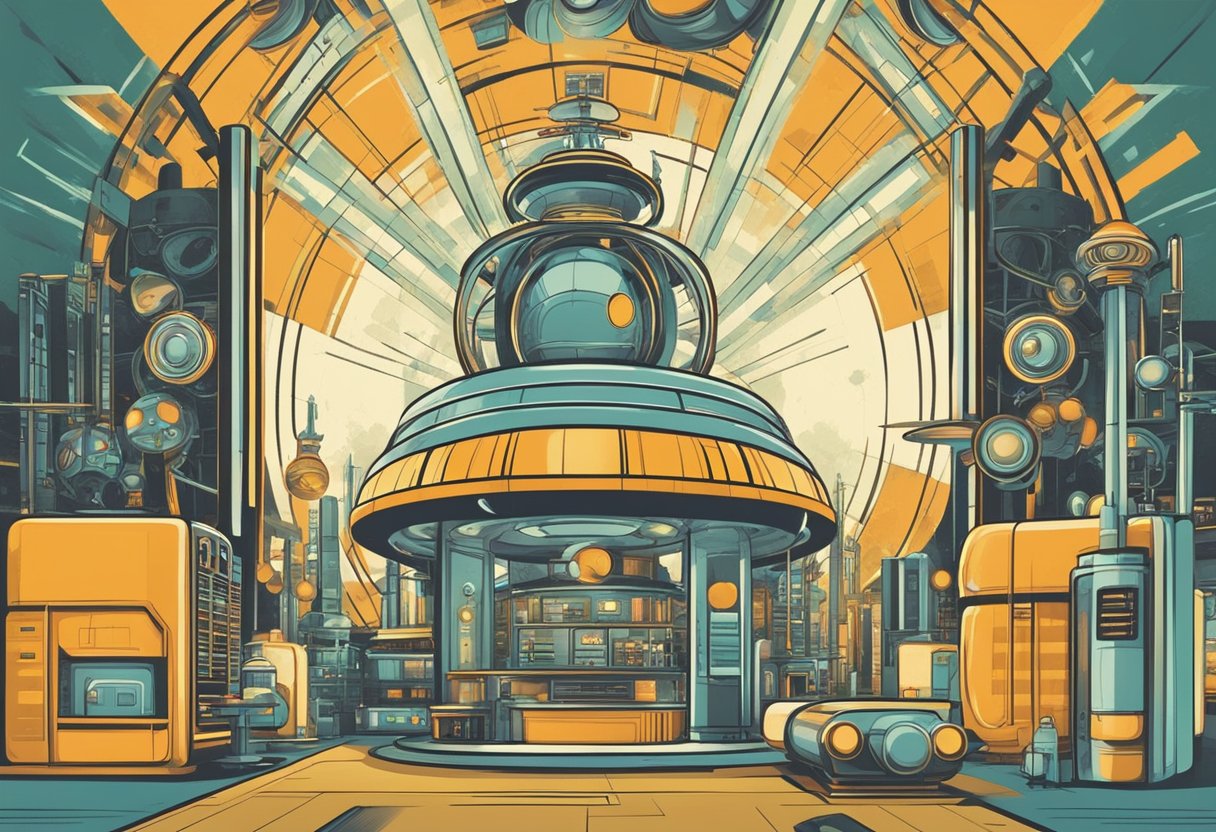
Atompunk is a growing subculture that has been gaining popularity in recent years. As such, it has begun to appear in various stores and products. Here are a few examples of where you can find Atompunk-related items:
- Stores: Some stores that cater to alternative subcultures, such as Hot Topic or Spencer’s, may carry Atompunk-themed clothing or accessories. Online marketplaces like Etsy or Redbubble also have a variety of Atompunk-inspired merchandise available.
- Cassettes: Atompunk music is often inspired by the electronic and experimental sounds of the 1950s and 60s. Some bands, such as The Time Travelers and The Gaslamp Killer, have released Atompunk-inspired albums on cassette tape.
- Rocket Ships: Atompunk is heavily influenced by the space race and the futuristic technology of the mid-20th century. As such, rocket ships and other space-related imagery are common in Atompunk art and design.
- Spheres: The atomic symbol is a common motif in Atompunk design, and is often represented by a sphere with orbiting electrons. This symbol can be found on clothing, accessories, and other Atompunk merchandise.
Overall, Atompunk is a subculture that is still emerging and evolving. As such, it is likely that we will continue to see more Atompunk-related products and designs in the future.
Conclusion
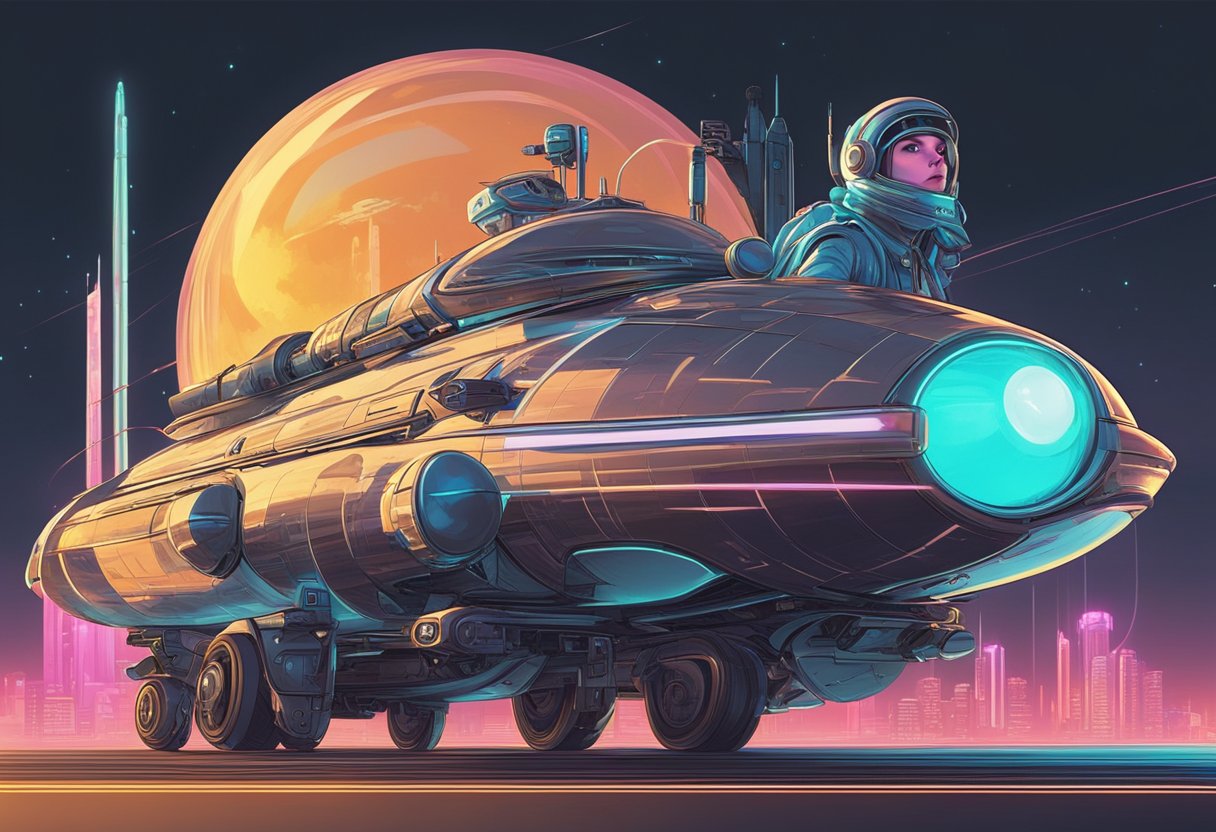
In conclusion, Atompunk is a subgenre of speculative fiction that draws inspiration from the Atomic Age of the mid-20th century. It is characterized by its retro-futuristic aesthetic, which combines elements of science fiction and vintage design.
Atompunk is a relatively new term, coined in the early 21st century, but it has quickly gained popularity among fans of science fiction and retro-futurism. It is often associated with other subgenres such as Cyberpunk and Steampunk, but it has its own unique aesthetic and themes.
The Atompunk genre is rooted in the fear and fascination with the power of atomic energy that emerged after the bombings of Hiroshima and Nagasaki in 1945. It imagines a world where the atomic age continued to shape society, technology, and culture in unique ways.
Atompunk stories often explore themes of nuclear power, Cold War politics, and the dangers of scientific progress. They also often feature retro-futuristic technology such as ray guns, rocket ships, and giant robots.
Overall, Atompunk is a fascinating subgenre of speculative fiction that offers a unique blend of nostalgia and imagination. It is a genre that is sure to continue to captivate readers and fans of science fiction for years to come.
